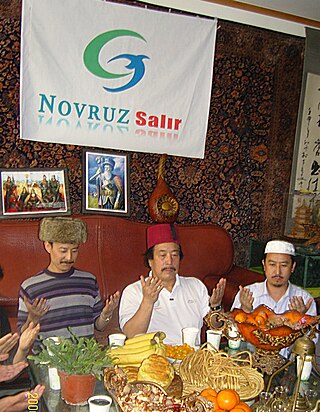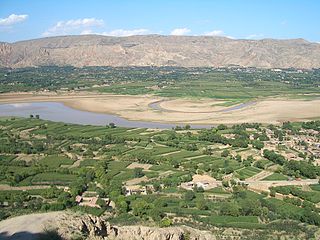
Qinghai is a landlocked province in the northwest of the People's Republic of China. It is the largest province of China by area and has the third smallest population. Its capital and largest city is Xining.

The Dongxiang people are a Mongolic people and one of 56 ethnic groups officially recognized by the People's Republic of China. Half of the population live in Dongxiang Autonomous County, Linxia Prefecture, Gansu Province, China. According to the 2010 census, their population numbers 621,500, although research has found that the number is inflated due to Hui identifying themselves as Dongxiang for the census, in order to benefit from minority policies.

The Monguor, the Tu people, the White Mongol or the Tsagaan Mongol, are Mongolic people and one of the 56 officially recognized ethnic groups in China. The "Tu" ethnic category was created in the 1950s.

The Salar people are a Turkic ethnic minority in China who largely speak Salar, an Oghuz language. The Salar people numbered 130,607 people in the census of 2010.
The Santa language, also known as Dongxiang, is a Mongolic language spoken by the Dongxiang people in Northwest China.

Tibetan Muslims, known in Tibet as the Khache, are Tibetans who adhere to Islam. Many are descendants of Kashmiris, Ladakhis, and Nepalis who arrived in Tibet in the 14th to 17th centuries. There are approximately 5,000 Tibetan Muslims living in China and over 1,500 living in India.
The Monguor language is a Mongolic language of its Shirongolic branch and is part of the Gansu–Qinghai sprachbund. There are several dialects, mostly spoken by the Monguor people. A writing system was devised for Huzhu Monguor (Mongghul) in the late 20th century but has been little used.
The Kangjia language is a Mongolic language spoken by a Muslim population of around 300 people in Jainca (Jianzha) County, Huangnan Tibetan Autonomous Prefecture in Qinghai province of China. As to its taxonomic affiliation, Kangjia seems to be an intermediate between Bonan language and Dongxiang language (Santa).
The Wutun language is a Mandarin–Amdo–Bonan creole language. It is spoken by about 4,000 people, most of whom are classified as Monguor (Tu) by the Chinese government. Wutun speakers reside in two villages of Tongren County, eastern Qinghai province, China. It is also known as the Ngandehua language.

Linxia Hui Autonomous Prefecture, formerly known as Hezhou (河州) and Baohan (枹罕), is located in Gansu Province, south of the provincial capital Lanzhou, bordering Qinghai to the west. It is an autonomous prefecture for the Muslim Hui people, a large Chinese ethnic group. It also includes two autonomous counties for other Muslim groups, namely Bonan, Dongxiang and Salar.

Xunhua Salar Autonomous County is an autonomous county in the southeast of Haidong Prefecture, in Qinghai province, China. The autonomous county has an area of around 2,100 square kilometres (810 sq mi), and a population of approximately 161,600 inhabitants per a 2022 government publication. In the east it borders the province of Gansu and in the south and the west Huangnan Tibetan Autonomous Prefecture. Its postal code is 811100 and its capital is the town of Jishi.
The Bonan language is the Mongolic language of the Bonan people of China. As of 1985, it was spoken by about 8,000 people, including about 75% of the total Bonan ethnic population and many ethnic Monguor, in Gansu and Qinghai Provinces. There are several dialects, which are influenced to varying degrees — but always heavily — by Chinese and Tibetan, while bilingualism in Wutun is less common. The most commonly studied is the Tongren dialect. There is no writing system in use. The language is also referred to as "Manegacha", natively.

There were two Kazakh exoduses from Xinjiang. The first occurred in the 1930s and 1940s as Kazakhs fled from the Soviet Union into Xinjiang, Gansu, Qinghai, Tibet and British India. The second came in waves during the 1950s and 1960s after the victory of the Chinese Communist Party in Xinjiang.

The history of Islam in China dates back to 1,300 years ago. Currently, Chinese Muslims are a minority group in China, representing between 0.45% to 1.8% of the total population according to the latest estimates. Although Hui Muslims are the most numerous group, the greatest concentration of Chinese Muslims are located in Northwestern China, mostly in the autonomous region of Xinjiang, which holds a significant Uyghur population. Lesser but significant Chinese Muslim populations reside in the regions of Ningxia, Gansu, and Qinghai. Of China's 55 officially recognized minority peoples, ten groups are predominantly Sunnī Muslim.

As the Yuan dynasty ended, many Mongols as well as the Muslims who came with them remained in China. Most of their descendants took Chinese names and became part of the diverse cultural world of China. During the following Ming rule (1368–1644), Muslims truly adopted Chinese culture. Most became fluent in Chinese and adopted Chinese names and the capital, Nanjing, became a center of Islamic learning. As a result, the Muslims became "outwardly indistinguishable" from the Chinese.

After the fall of the Qing dynasty following the Xinhai Revolution (1911-1912), Sun Yat-sen, who led the new Republic of China (1912–1949), immediately proclaimed that the country belonged equally to the Han, Hui (Muslim), Meng (Mongol), and Tsang (Tibetan) peoples. When the People's Republic of China was established in 1949, Chinese Muslims suffered political repression along with all other religious groups in China, especially during the Cultural Revolution (1966–1976).
Jishishan Bonan, Dongxiang and Salar Autonomous County is an autonomous county of Linxia Hui Autonomous Prefecture, in Gansu province, China. It is located in the mostly mountainous area to the south of the Yellow River, near Gansu's border with Qinghai province. The total population was 239,390 in 2020; 64.9% were of an ethnic minority. The county's titular ethnic groups are the Bonan, Dongxiang, and Salar peoples. There are 21,400 Bonan people living in Jishishan, which accounts for 95% of all Bonan in China. The Bonan are known for their cultivation of Sichuan peppers and walnuts. Jishishan's local cuisine includes Bonan-style maisui baozi and lamb meat.
The Qinghai–Gansu sprachbund or Amdo sprachbund is a sprachbund in the plateau traversed by the upper Yellow River, including northeastern Qinghai and southern Gansu. This has long been an area of interaction between speakers of northwestern varieties of Mandarin Chinese, Amdo Tibetan and Mongolic and Turkic languages. These families feature contrasting typologies, which spread between languages in the region. The languages have come to share many features, and differ significantly from their relatives outside the region.









